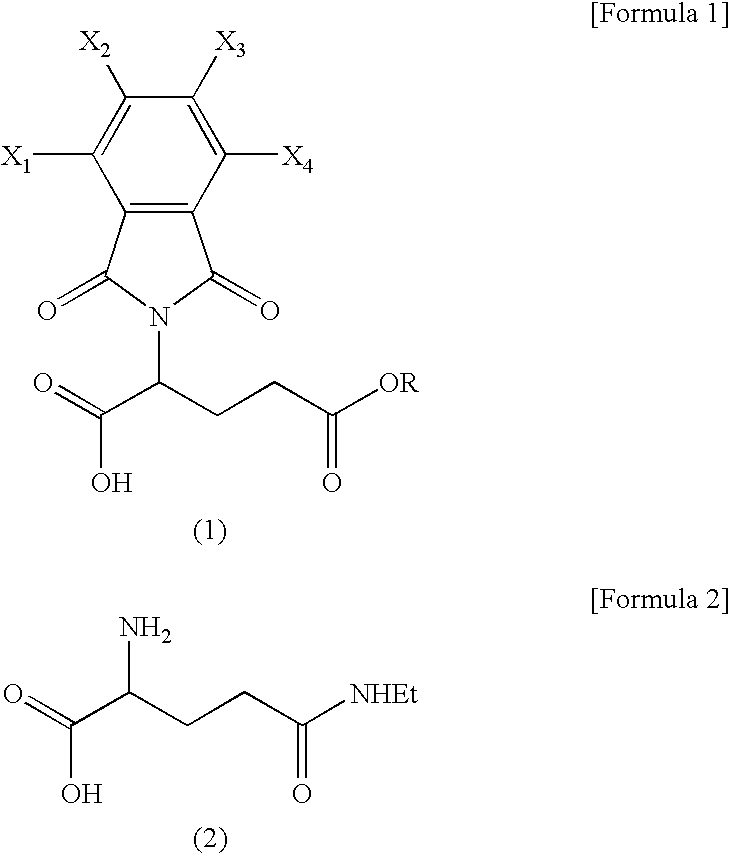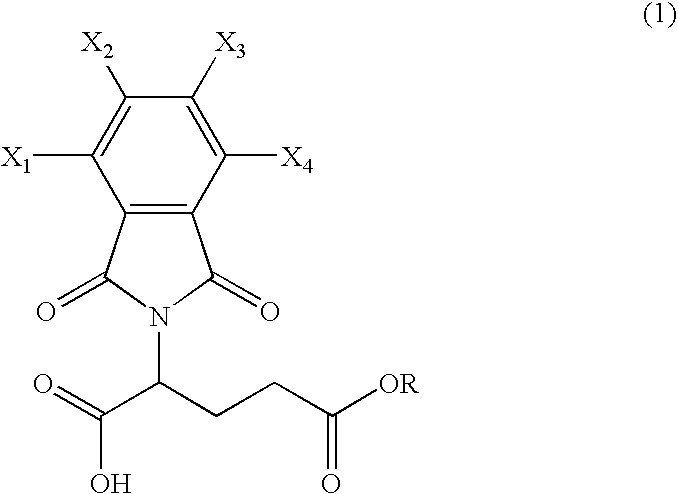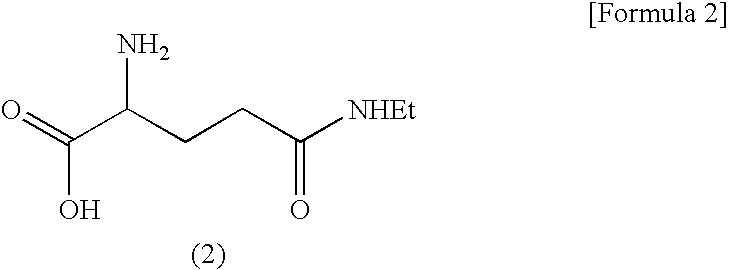Process for the Preparation of N(5)-Ethylglutamine
a technology of n-ethylglutamine and process, which is applied in the field of new products, can solve the problems of uneconomic extraction of theanine from expensive green tea in order to meet the increased demands, the use of expensive catalysts and inflammable hydrogen in the process of separating n-protecting groups, and the inability to meet the demand, so as to achieve economic and practical application of the present invention and achieve the effect of simplifying and safe reaction, reducing the risk of aging
- Summary
- Abstract
- Description
- Claims
- Application Information
AI Technical Summary
Benefits of technology
Problems solved by technology
Method used
Image
Examples
preparation example 1
Preparation of N-phthaloyl-L-glutamic acid 5-methyl ester (formula 1: R=Me, X1=X2=X3=X4=H)
[0028]160 g of toluene was added to 8.1 g of L-glutamic acid 5-methyl ester and 7.4 g of phthalic anhydride. Then, 2.5 g of triethylamine was added thereto and the mixture was stirred at reflux temperature for 6 hours. Here, generated water was removed using a water separator. Toluene was distilled off under reduced pressure and 100 ml of ethyl acetate and 50 ml of 1N hydrochloric acid solution were added thereto. After separating the resulting solution layers, the organic layer was washed with water and dried with magnesium sulfate. The solvent was distilled off under reduced pressure, thus obtaining a target compound in a white solid phase quantitatively.
[0029]NMR (CDCl3)δ(ppm) 9.68 (broad, 1H), 7.90˜7.72 (m, 4H), 5.00 (dd, 1H), 3.62 (s, 3H), 2.69˜2.44 (m, 2H), 2.41 (m, 2H)
preparation example 2
Preparation of N-Phthaloyl-L-glutamic acid 5-ethyl ester (formula 1: R=Et, X1=X2=X3=X4=H)
[0030]Using 8.8 g of L-glutamic acid 5-ethyl ester instead of L-glutamic acid 5-methyl ester, a target compound in a white oil phase was obtained quantitatively via the same process as preparation example 1.
[0031]NMR (CDCl3)δ(ppm): 10.62 (broad, 1H), 7.90˜7.72 (m, 4H), 5.00 (dd, 1H), 4.04 (q, 2H), 2.68-2.40 (m, 2H), 2.41 (m, 2H), 1.20 (t, 3H)
preparation example 3
Preparation of N-tetrachlorophthaloyl-L-glutamic acid 5-methyl ester (formula 1: R=Me, X1=X2=X3=X4=Cl)
[0032]Using 14.3 g of tetrachlorophthalic anhydride instead of phthalic anhydride, a target compound was obtained quantitatively in a white solid phase via the same process as preparation example 1.
[0033]NMR (DMSO-d6)δ(ppm): 4.86 (dd, 1H), 3.56 (s, 3H), 2.52˜2.15(m, 4H)
PUM
 Login to View More
Login to View More Abstract
Description
Claims
Application Information
 Login to View More
Login to View More - R&D
- Intellectual Property
- Life Sciences
- Materials
- Tech Scout
- Unparalleled Data Quality
- Higher Quality Content
- 60% Fewer Hallucinations
Browse by: Latest US Patents, China's latest patents, Technical Efficacy Thesaurus, Application Domain, Technology Topic, Popular Technical Reports.
© 2025 PatSnap. All rights reserved.Legal|Privacy policy|Modern Slavery Act Transparency Statement|Sitemap|About US| Contact US: help@patsnap.com



